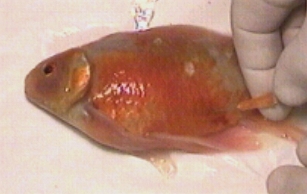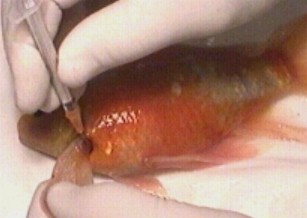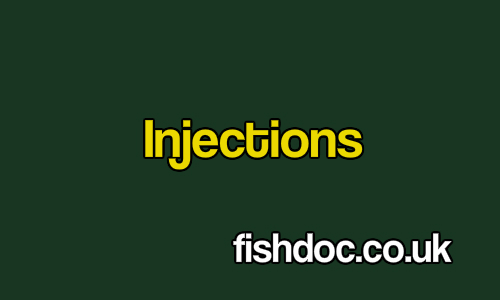Antibiotic injections:
Injection of antibiotics gives the best success rate, especially when dealing with advanced bacterial infections. Injections give a measured amount of drug directly into the body, leading to high blood and tissue levels of antibiotic. The disadvantages are that handling will often cause stress and a certain amount of skill is necessary in handling fish during this procedure. In most cases the fish will need to be sedated, especially if there are any lesions that need cleaning and dressing (see anaesthetics pages).
How to inject antibiotics
- The first step is to estimate the fish’s weight, or preferably weigh the fish, to determine the drug dosage
- Calculate the required dosage, which will depend on the antibiotic being used and its concentration. The volume of antibiotic required can be calculated from;
|
Volume of antibiotic =
recommended dosage (mg/kg) x weight of fish (kg)
solution concentration (mg/ml)
|
|
(1ml = 1000 mg therefore 5% concentration = 50mg active antibiotic per ml)
Example: To treat a 1.5kg fish with a 5% antibiotic solution at a recommended dosage of 10mg/kg
|
|
10 (mg/kg) x 1.5 (kg)
50 (mg/ml)
|
= 0.3 ml antibiotic
|
 |
For injections use a fine (25 gauge or less) needle |
 |
The injection site should be swabbed with antiseptic – povodine-iodine or similar |
 |
Make sure syringe is free of air-bubbles |
Injection sites
This seems to be very much a matter of personal choice and there is little evidence to suggest that there are any real differences in results
- IP (intraperitoneal). The drug is injected into the abdominal cavity. The injection is made just anterior to the anus near to the ventral midline. The needle is inserted at a shallow angle to avoid penetrating the internal organs, until it is just past the body wall. This can be detected by the lack of resistance and free movement of the end of the needle. However, there is a risk of damage to a major organ or injection of antibiotic into the bowel, in which case the drug would simply be passed back out with the faeces.
 Intraperitoneal injection. Note the narrow angle, with the injection being made just in front of and to one side of the anus Intraperitoneal injection. Note the narrow angle, with the injection being made just in front of and to one side of the anus |
|
|
 |
IM (intramuscular) sites: There are several sites including midway between the dorsal fin and the lateral line (midline dorsal site), the musculature of the peduncle or flank (towards the tail), or the pectoral fin muscles. My own preference is the pectoral fin muscle, as the drug seems to be quickly taken up with little or no “blowback” in which the antibiotic comes out of the site as the needle is withdrawn. The drawback with the pectoral fin site is that only small volumes of drug can be injected, which is fine if you are using a low volume dosage antibiotic such as enrofloxacin, but no good for high volume drugs such as Borgal®. This site is not practical with smaller fish because of the lack of muscle in this area. If you are using multiple injections over a period, it is best to alternate the pectoral fin muscle used. Whatever site is chosen, the injection should be done slowly to maximise the deposition of antibiotic. |
 Intramuscular injection made into the pectoral fin muscle using approx. 0.05 ml enrofloxacin Intramuscular injection made into the pectoral fin muscle using approx. 0.05 ml enrofloxacin |
|
|
Dosages
|
Injectable antibiotics used to treat bacterial disease in ornamental fish
|
| amoxycillin |
injection: 12.5 mg/kg single dose long acting preparation
|
| ampicillin |
injection: 10 mg/kg daily |
| Borgal® |
injection: 75mg/ kg at four day intervals |
| choramphenicol |
injection: 40 mg/kg daily
|
| co-trimazine |
injection: 30 mg/kg on alternative days
|
| enrofloxacin |
injection: 5-10 mg/kg on alternative days 3-5 injections
|
| gentamicin |
injection: 3-5 mg/kg on alternative days # |
| oxytetracycline |
injection: 10 mg/kg single dose long-acting preparation *
|
|
# = can be toxic to kidney tissue
*= can cause sterile cysts at injection site
|
|
|

 Intraperitoneal injection. Note the narrow angle, with the injection being made just in front of and to one side of the anus
Intraperitoneal injection. Note the narrow angle, with the injection being made just in front of and to one side of the anus Intramuscular injection made into the pectoral fin muscle using approx. 0.05 ml enrofloxacin
Intramuscular injection made into the pectoral fin muscle using approx. 0.05 ml enrofloxacin